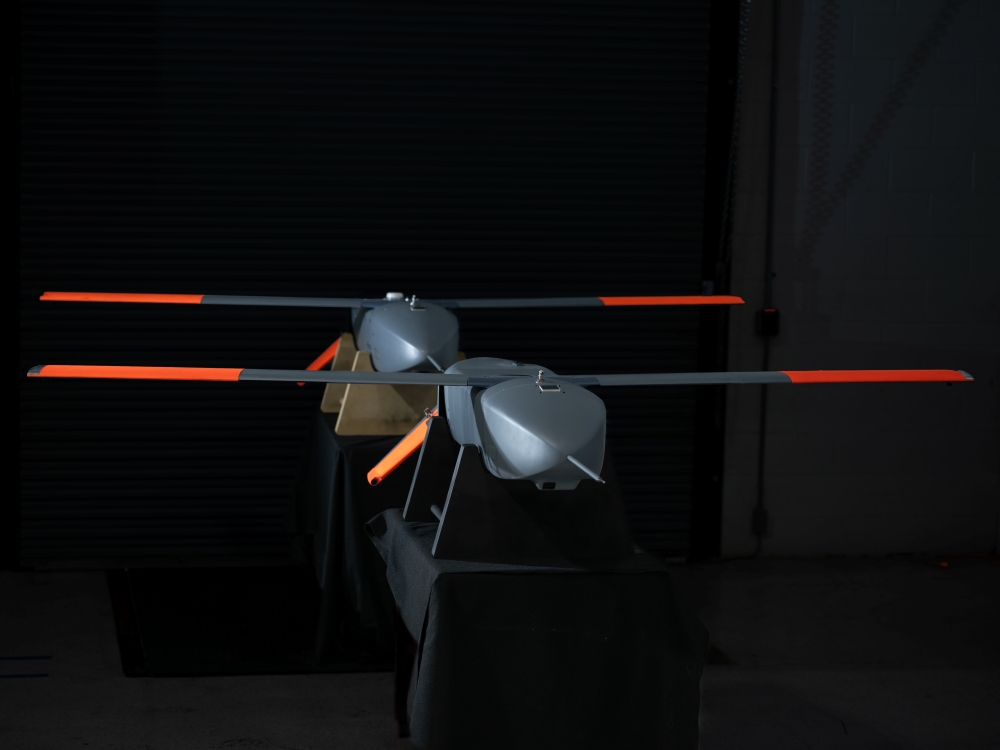
Northrop Grumman's LUMBERJACK is a jet-powered, modular Group 3 uncrewed aircraft system (UAS) delivering affordable, attritable precision strike and electronic warfare capabilities. The 290-pound (131,5kg) platform launches from air, ground, or maritime platforms, employs kinetic or non-kinetic payloads from beyond-line-of-sight ranges, and integrates AI-enabled autonomous operations through open architecture software.
In a conversation with Michel Bastin, the company's Director of Programmes, what emerges is a fundamental reconceptualization of how Northrop Grumman approaches product development, manufacturing partnerships, and requirements-driven design in an era demanding affordable mass.
The development philosophy behind LUMBERJACK inverts traditional acquisition logic. Rather than waiting for customers to define granular requirements and then engineering a bespoke solution over multiple years, Northrop Grumman identified a clear market signal for cost-effective, rapidly deployable systems and designed backwards from that commercial reality. This approach allowed the team to progress from concept to first flight in just fourteen months, achieving Technology Readiness Level (TRL) 6 shortly thereafter through iterative build-fly-integrate cycles that would be inconceivable under conventional acquisition frameworks (a trend that is increasingly popping up in the Defence sector).
Central to this accelerated timeline was Northrop Grumman's strategic embrace of non-traditional partners. The company positioned itself as prime contractor and lead systems integrator while delegating manufacturing to Empirical Systems Aerospace (ESAero), a San Luis Obispo-based aerospace firm specializing in rapid prototyping and low-rate initial production for Group 2 and 3 unmanned systems. ESAero's manufacturing philosophy emphasizes affordability and flexible production scaling, having previously partnered with companies ranging from AeroVironment to Red Cat Holdings on similar ventures. This partnership allowed Northrop Grumman engineers to translate new design features into testable hardware within days or weeks rather than months, fundamentally compressing the innovation cycle.
Equally significant is the integration of Palantir Technologies Inc. for software architecture and artificial intelligence (AI) capabilities. Palantir's hardware-agnostic Artificial Intelligence Platform enables LUMBERJACK to process data both at the tactical edge through onboard computing and via networked connectivity to centralized processing nodes. This dual-layer architecture supports autonomous flight operations while maintaining human-on-the-loop positive control through both line-of-sight and beyond-line-of-sight communications. The system can receive software updates and incorporate new AI and machine learning models within hours, a capability that addresses the perpetually shifting requirements landscape Bastin identified as characteristic of contemporary defence planning.
The modular payload architecture represents another departure from traditional single-mission platform design. LUMBERJACK’s centre bay accommodates kinetic effects including Northrop Grumman's HATCHET precision strike weapon, non-kinetic electronic warfare systems, or intelligence-surveillance-reconnaissance (ISR) sensor packages. Bastin emphasized that the payload bay was intentionally designed to most compliance standards, enabling customers to install their own mission-specific equipment and rapidly reconfigure the platform based on evolving threat assessments. This open systems approach extends beyond physical payloads to the control architecture itself, which can integrate with existing ground control stations and mission planners without requiring specialized hardware.
Launch versatility underscores the platform's operational flexibility. LUMBERJACK has demonstrated compatibility with both pneumatic and electric rail launchers provided by third-party manufacturers, with Bastin noting that Northrop Grumman remains deliberately launcher-agnostic. The platform can launch every 90 seconds from systems like the Runway Independent Launcher developed for the Navy. Air-launch development is progressing for 2026 flight demonstrations, with compatibility planned across manned and unmanned platforms ranging from rotorcraft to fast jets capable of carrying Small Diameter Bomb-class munitions. LUMBERJACK was deliberately sized to match GBU-39 dimensions, maximizing the number of potential host platforms.
The recoverable design for training applications emerged as a particularly nuanced capability during the discussion. While LUMBERJACK functions as an attritable one-way attack platform in combat scenarios, the system supports reusable training missions where the aircraft returns for refurbishment and redeployment. Multiple physical or virtual LUMBERJACK units can operate simultaneously, coordinating through onboard autonomy engines and communications systems to execute complex multi-platform training scenarios. This generates substantial operational data that feeds back into both immediate training analysis and longer-term systems development through edge processing and network connectivity.
Bastin's observations about organizational transformation within Northrop Grumman reveal cultural shifts accompanying these technical innovations. The expanded role of commercial partners represents more than outsourcing manufacturing capacity. These partnerships bring speed-to-market advantages that even large primes struggle to match through internal development processes. Designing with open standards from inception rather than incorporating them retroactively fundamentally changes engineering workflows and interface specifications. The willingness to field scalable, readily available capabilities and accept current system performance in the absence of defined requirements reflects pragmatic adaptation to fiscal constraints and proliferation demands.
The Technology Readiness Experimentation (T-REX) framework that validated LUMBERJACK demonstrates how the Pentagon is institutionalizing rapid prototyping beyond isolated pilot programs. Hosted by the Office of the Under Secretary of Defence for Research and Engineering (OUSD (R&E)), T-REX events provide operationally relevant test environments for technologies at readiness levels four through six, allowing industry partners to demonstrate capabilities to actual military operators and receive immediate feedback for iterative refinement. LUMBERJACK twice participated in T-REX earlier in 2025, demonstrating end-to-end mission execution and launcher compatibility while exposing the system to realistic electromagnetic warfare environments and target engagement scenarios.
Export considerations factored into design decisions from the outset. Bastin confirmed that Northrop Grumman has initiated regulatory processes for international sales, with the extensive use of commercial technology simplifying export compliance compared to platforms incorporating more sensitive government-furnished equipment. Multiple domestic transition partners are already engaged for 2026 flight demonstrations targeting service-specific requirements refinement.
What distinguishes this development model is not any single technical innovation but rather the systematic integration of commercial manufacturing capacity, software-defined functionality, open architecture interfaces, and requirements flexibility into a coherent acquisition strategy. Traditional defence contractors have historically maintained vertical integration and designed to detailed specifications. LUMBERJACK suggests an alternative where primes orchestrate ecosystems of specialized partners, design platforms around modular capability insertion, and proactively develop solutions that address broad mission categories rather than waiting for formalized requirements.
The implications extend beyond unmanned systems. If affordable mass truly becomes the organizing principle for future force structure, the methodologies Northrop Grumman employed for LUMBERJACK offer a template for accelerating capability delivery across domains. Success depends on maintaining the delicate balance between technical performance, unit cost, development speed, and operational versatility that Bastin and his team navigated. The platform's progression from concept to operational testing in just over a year demonstrates that major contractors can adapt acquisition timelines when organizational incentives align with strategic imperatives.








.png)
